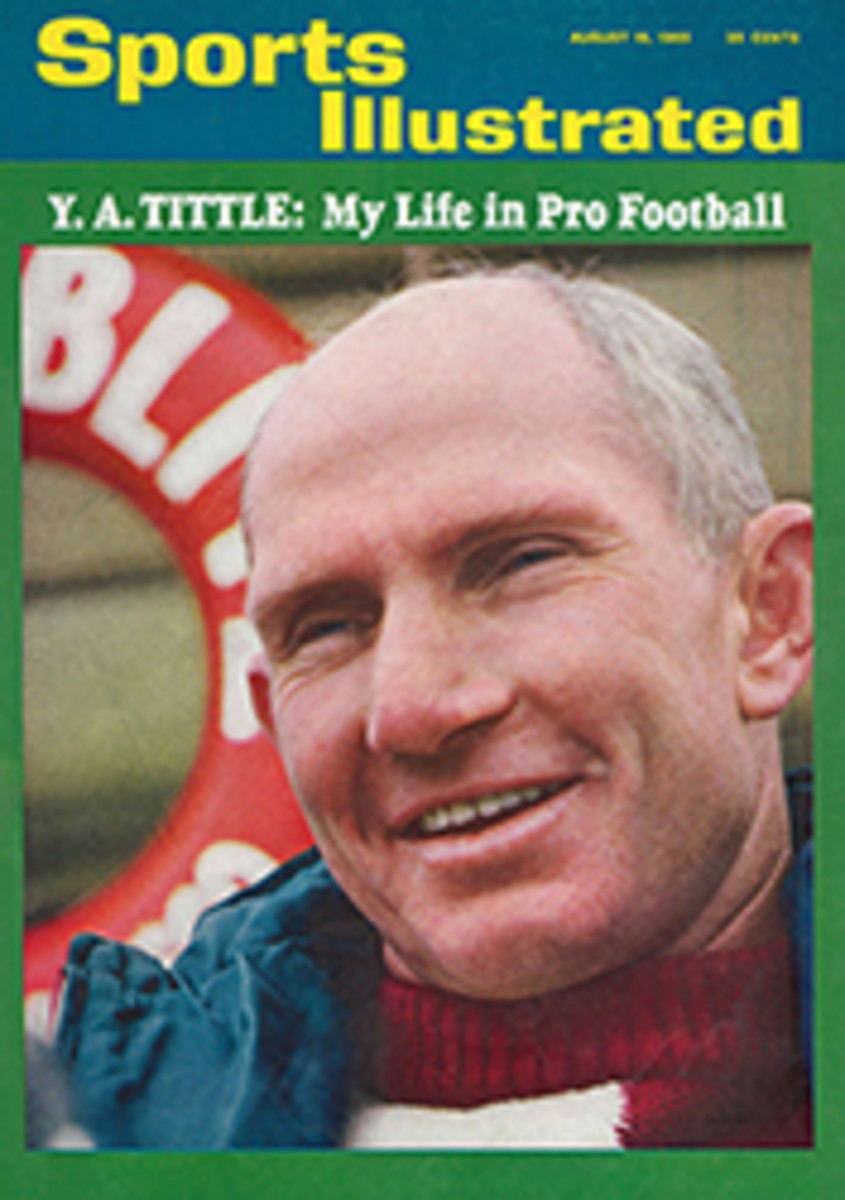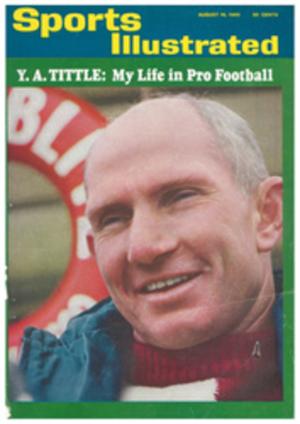
A star is born—about 40 minutes too late
If one of Donald Duck's nephews had been there he presumably would have played ahead of John Huarte, too, and the 1965 College All-Stars would be forced to walk around today in false beards and dark glasses. Until Huarte—the Notre Dame quarterback for whom the New York Jets paid $200,000 less than Joe Namath—finally got into the game against the Cleveland Browns last week in Chicago, the All-Stars had looked like the most disappointing group of professional rookies since Phil Spitalny recruited his all-girl orchestra.
Before Huarte's spicy sidearm passing and slick ball-handling trimmed the Browns' winning margin down to 24-16, the situation was this: third quarter halfway gone, the rain still falling on Soldier Field, the Browns leading 24-3 despite more holding penalties than a man would draw on a date with Candy Bergen, and most television sets by now switched over to a Randolph Scott movie—or off.
At this point, the All-Stars looked as pepless and disinterested in the game as their coach, Otto Graham, had feared they might be. "They just don't seem very enthusiastic," said Otto at one of the last dreary practice sessions. "Either they're too cocky because of their big bonuses, or they simply would rather be in their own pro camps instead of here."
One thing was certain. They were not in the 32nd annual All-Star Game. They had not been able to move the football in any of the classical ways—particularly forward. Starting Quarterback Roger Staubach had run around some and had hit Fred Biletnikoff three times before Galen Fiss sent him to the hospital. But the Browns doubled the coverage on the fine Florida State receiver, and that was that. Craig Morton, a classic drop-back passer who came in for Staubach after he was hurt, had done nothing more than drop back and fall down. And Bob Hayes, the Olympic sprint champion who hopes to make it as a flanker with the Dallas Cowboys, had not been able to decide whether to run or not with a couple of punts and a pass. Which left inconclusive the matter of his ability to catch the ball. As one pro scout put it, "He's got 9.1 speed, but 12-flat hands."
The All-Stars had even committed one of football's most dreadful sins, that of allowing a punt to be blocked. It occurred when the collegians were backed up to their own 17-yard line and Tackle Archie Sutton forgot to enter the game to help protect the punter, Frank Lambert. Cleveland's Jamie Caleb simply poured through the hole, smothered the kicker and then nonchalantly allowed teammate Stan Sczurek to recover the ball in the end zone for the touchdown that ultimately made the big difference in the game.
Only on defense did the All-Stars, in those first two and a half quarters, unveil any notable performers. One was Dick Butkus, the ferocious linebacker from Illinois. Though he guessed wrong frequently, he was everywhere, recovering nicely and slamming ballcarriers, even Jim Brown, around like toys.
"Butkus," said Graham later, "is possibly the best All-Star I've had in camp in the whole 10 years I've coached the team." To which Cleveland Quarterback Frank Ryan added, "All I can say is I predict a long and illustrious career for Mr. Butkus."
The collegians also had a less heralded but no less aggressive defensive back named Al Nelson, from Cincinnati. Quick and full of instinct. Nelson looked like an NFL veteran in the secondary. He could be credited with intimidating the Browns' Gary Collins into dropping a touchdown pass in the end zone, with hitting Collins so hard once that Gary took a long, long time to get up and with making the spectacular diving tackle on a deep pass that resulted in a broken collarbone for Paul Warfield, putting Cleveland's swiftest receiver out for at least six weeks and no doubt making Coach Blanton Collier speculate whether the game is really necessary.
But Butkus and Nelson were not enough to keep the All-Stars in the game, even though Ryan was not sharp and had what he described aptly as "an inconceivably bad night," and the Browns drew constant offensive penalties. It remained for Huarte, who completed all of his first nine passes—and 10 of 13 for 137 yards and two touchdowns—to save the occasion. And in making the show a success he also made stars out of a lot of unlikely people—out of Chuck Mercein of Yale, the game's only Ivy Leaguer, out of Navy's Pat Donnelly, who won't even play pro football, and out of Oklahoma's Lance Rentzel, who up to game time could not beat out Fred Biletnikoff. Huarte did it by simply shaking the team to life and throwing the ball to somebody.
He threw dropping straight back, and he threw scrambling out to either side. He threw both short and long, with both a dry and wet ball, and always, invariably, to the open receiver. His pet targets were Mercein, Rentzel and Donnelly, and not his former Notre Dame teammate, Jack Snow, as everyone (especially the Browns) had figured.
Huarte concluded his first of two 80-yard scoring drives by somehow finding Mercein, hiding among a cluster of Browns in the end zone, and drilling the ball so firmly into his chest that even a Vale man couldn't drop it. His touchdown pass to Rentzel was also for only five yards, but it, too, was a gem. Lance had broken his pattern to get free, yet Huarte saw his move, darted around and whipped the ball to him.
"I don't know," said Dick Gallagher, the general manager of the Buffalo Bills and former assistant coach for the Cleveland Browns. "No one thinks the guy can throw good enough, but he reminds me of a young Bobby Layne. Not pretty, but accurate—and a leader."
Lance Rentzel talked about that leader business.
"He has that indefinable quality called leadership," said the flanker who demonstrated that the Minnesota Vikings may have a pretty good find of their own. "John comes in the game knowing he's going to do well, and he does it. He makes you feel it, too."
The question to Otto Graham, of course, was how all this could be possible and the All-Star coach not know it after three weeks of preparations.
"All I can say is that John's a game player," Graham said. "His practices just weren't impressive. I judged Staubach's ability as ranging from exceptional to fantastic. And Morton looked tremendous throwing the ball. We went first with Roger because he could scramble, and we hoped he might wear down some of those big Brown linemen. Johnny simply wasn't as good in our workouts. I really rated him No. 4, even behind Bob Timberlake."
Many of the players themselves were talking about how disappointing Huarte had looked before the game. Among them, the worst prophet was Rice Linebacker Russell Wayt, who said, "Johnny's a heck of a nice guy, but he's just not a passer."
Huarte's sidearm delivery and lack of concern for the perfect spiral combine to make him look like something less than the cover photo thrower.
"But you can't argue with accuracy," said Graham. "And I wouldn't change him now—never. Let him throw that way."
All Huarte knew is that he was capable of moving the team, and he was not the least surprised at what he did. "It's a good question why I don't do better in workouts. Coach Graham was right. Roger certainly deserved to start. But I knew that if I got in the game, I'd do well. I just felt it," he said.
If he keeps on feeling it, the New York Jets may discover that they gave the biggest bonus check to the wrong quarterback.
PHOTO
ILLINOIS' DICK BUTKUS (No. 50) hurtles into Cleveland interference to break up a play. The other hero of the game, Butkus drew praise as the best All-Star defense man in a decade.

